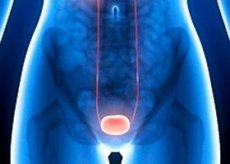Medical expert of the article
New publications
Overactive bladder
Last reviewed: 04.07.2025

All iLive content is medically reviewed or fact checked to ensure as much factual accuracy as possible.
We have strict sourcing guidelines and only link to reputable media sites, academic research institutions and, whenever possible, medically peer reviewed studies. Note that the numbers in parentheses ([1], [2], etc.) are clickable links to these studies.
If you feel that any of our content is inaccurate, out-of-date, or otherwise questionable, please select it and press Ctrl + Enter.

Overactive bladder is a clinical syndrome that defines urgent urination with or without urgent urinary incontinence, which is usually accompanied by frequent urination and nocturia. Overactive bladder occurs due to detrusor overactivity of a neurogenic or idiopathic nature. Neurogenic detrusor overactivity is associated with neurological diseases.
 [ 1 ]
[ 1 ]
Causes overactive bladder
In idiopathic detrusor overactivity, the cause of involuntary detrusor contractions is unknown. When urinary frequency and urgency are not accompanied by detrusor overactivity, in the absence of other causes, the term "overactive bladder without detrusor overactivity" is used.
Thus, the term "overactive bladder" is a general one, denoting all the above-mentioned disorders of the act of urination and at the same time does not claim to replace the well-known terminology of the International Continence Society, which is used by a narrow circle of urologists.
Terminology of the International Continence Society according to Abrams P. et al. (2002).
Terms to be replaced |
Recommended terms |
Detrusor hyperreflexia |
Neurogenic detrusor overactivity |
Detrusor instability |
Idopathic detrusor overactivity |
Motor urgency |
Absent |
Sensory urgency |
Overactive bladder without detour overactivity |
Motor urge urinary incontinence |
Urinary incontinence due to detrusor overactivity with imperative urge to urinate |
Reflex urinary incontinence |
Urinary incontinence due to detrusor overactivity without urge to urinate |
It has been reliably established that overactive bladder can be a consequence of neurogenic and non-neurogenic lesions. Neurogenic disorders occur at the level of supraspinal centers of the nervous system and the spinal cord pathways, while non-neurogenic disorders are a consequence of age-related changes in the detrusor, IVO, and anatomical changes in the position of the urethra and bladder.
Some morphological changes of the detrusor are known in hyperactivity.

Thus, most patients with overactive bladder show a decrease in the density of cholinergic nerve fibers, which have increased sensitivity to acetylcholine. These changes are called "post-synaptic cholinergic denervation of the detrusor."
Symptoms overactive bladder
Overactive bladder has the following symptoms: frequent daytime and nighttime urination; they occur approximately 2 times more often in the absence of urgent urination and 3 times more often without urgent urinary incontinence. Urgent urinary incontinence is the most severe manifestation of overactive bladder, since it causes significant suffering to patients. The peculiarity of the course of overactive bladder is the dynamics of its symptoms. Over 3 years of observation, urgent urinary incontinence spontaneously regresses in almost a third of patients without treatment and relapses again at different times.
What do need to examine?
How to examine?
What tests are needed?
Who to contact?
Treatment overactive bladder
Overactive bladder is treated primarily with the aim of restoring lost control of the bladder's storage function. For all forms of overactive bladder, the main treatment method is medication. The standard drugs of choice are anticholinergics (m-anticholinergics). As a rule, medication is combined with behavioral therapy, biofeedback, or neuromodulation.
The mechanism of action of anticholinergic drugs is the blockade of postsynaptic (m2, m1) muscarinic cholinergic receptors of the detrusor. This reduces or prevents the action of acetylcholine on the detrusor, reducing its hyperactivity and increasing the capacity of the bladder.

